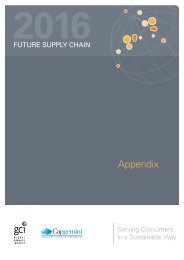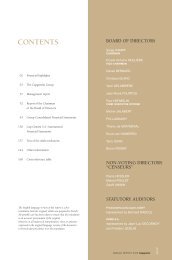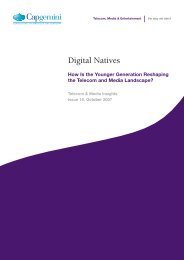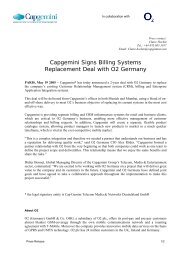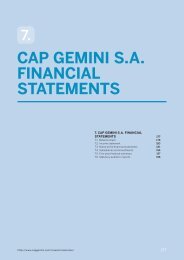You also want an ePaper? Increase the reach of your titles
YUMPU automatically turns print PDFs into web optimized ePapers that Google loves.
Other financial liabilities<br />
With the exception of derivative instruments, other financial liabilities<br />
are measured at amortized cost, calculated in accordance with the<br />
principles set out above.<br />
Derivative instruments are measured at fair value in accordance with<br />
the principles set out above in a) Recognition and measurement of<br />
financial assets.<br />
N) Net cash and cash equivalents<br />
Net cash and cash equivalents comprise cash and cash equivalents<br />
less short- and long-term financial debt.<br />
Cash and cash equivalents correspond to short-term investments<br />
and cash, less bank overdrafts and derivative instruments when the<br />
underlying elements to which these relate are included in net cash<br />
and cash equivalents.<br />
O) Pensions and other post-employment benefits<br />
Defined contribution plans<br />
Defined contribution plans are funded by contributions paid by<br />
employees and Group companies to the organizations responsible<br />
for managing the plans. The Group’s obligations are limited to the<br />
payment of such contributions which are recorded in the statement<br />
of income as incurred.<br />
Defined benefit plans<br />
Defined benefit plans consist of either:<br />
Unfunded plans, where benefits are paid directly by the Group. The<br />
related obligation is covered by a provision corresponding to the<br />
discounted present value of future benefit payments. Estimates are<br />
based on regularly reviewed internal and external parameters;<br />
Funded plans, where the benefit obligation is covered by external<br />
funds. Group contributions to these external funds are made in<br />
accordance with the specific regulations in force in each country.<br />
Obligations under these plans are generally determined by independent<br />
actuaries using the projected unit credit method. Under<br />
this method, each period of service gives rise to an additional<br />
unit of benefit entitlement and each of these units is valued<br />
separately in order to obtain the amount of the Group’s final<br />
commitment.<br />
The resulting obligation is discounted by reference to market yields<br />
on high quality corporate bonds, of a currency and term consistent<br />
with the currency and term of the post-employment benefit obligation.<br />
For funded plans, only the deficit is covered by a provision.<br />
Current and past service costs – corresponding to an increase in<br />
the obligation – are respectively recorded in operating expense<br />
as incurred, over the residual vesting period of the rights concerned.<br />
The impact during the year of discounting pension benefit obligations,<br />
as well as any changes in the expected return on plan assets, is<br />
recorded under “Other financial income and expense, net”.<br />
Actuarial gains and losses correspond to the effect of changes in<br />
actuarial assumptions and experience adjustments (i.e., differences<br />
between projected actuarial assumptions and actual data) on the<br />
amount of the defined benefit obligation or the value of plan assets.<br />
The Group has decided to recognize in equity the full amount of<br />
actuarial gains and losses relating to defined benefit plans in the<br />
period in which they arise, in line with the amendment to IAS 19<br />
– “Employee Benefits: Actuarial Gains and Losses, Group Plans and<br />
Disclosures”, effective January 1, 2006 (see Note 2 – “Change in<br />
accounting method”).<br />
P) Stock options granted to employees<br />
Stock options may be granted to a certain number of Group employees<br />
entitling them to purchase Cap Gemini shares issued for this purpose<br />
over a period of five or six years, at an exercise price set when the<br />
options are granted.<br />
Stock options are measured at fair value, corresponding to the value<br />
of the benefit granted to the employee on the grant date. The amount<br />
is recognized in “Other operating income and expense, net” in the<br />
statement of income on a straight-line basis over the option vesting<br />
period, with a corresponding adjustment to equity.<br />
The fair value of stock options is calculated using the Black and Scholes<br />
option pricing model which incorporates assumptions concerning<br />
the option exercise price and the vesting period, the share price at the<br />
date of grant, implicit share price volatility, and the risk-free interest<br />
rate. The expense recognized also takes into account staff attrition<br />
rates for eligible employee categories.<br />
In accordance with IFRS 1 – “First-time Adoption of International<br />
Financial Reporting Standards”, only stock options granted after<br />
November 7, 2002 with a vesting date after January 1, 2005, are<br />
measured and recognized as “Other operating income and expense,<br />
net”. Recognition and measurement of stock options granted prior<br />
to November 7, 2002 is not required.<br />
Q) Provisions<br />
A provision is recognized in the balance sheet if, and only if, (i) the<br />
Group has a present obligation (legal or constructive) as a result of<br />
a past event; (ii) it is probable that an outflow of resources embodying<br />
economic benefits will be required to settle the obligation; and<br />
(iii) a reliable estimate can be made of the amount of the obligation.<br />
Provisions are discounted when the impact of the time value of<br />
money is material.<br />
R) Consolidated statement of cash flows<br />
The consolidated statement of cash flows analyzes cash flows from<br />
operating, investing and financing activities.<br />
S) Segment Information<br />
The Group’s operations are managed on the basis of geographic<br />
areas, business segments and its clients’ business lines. Only the<br />
geographic entities constitute profit centers for which detailed performance<br />
measurements exist. The primary reporting corresponds to<br />
the geographic areas housing the Group’s operations. The secondary<br />
reporting corresponds to the Group’s business segments.<br />
Costs relating to operations and incurred at Group level on behalf<br />
of geographic areas and business lines are attributed to the segments<br />
concerned either directly or on the basis of reasonable assumptions.<br />
Items that have not been allocated correspond to headquarters’<br />
expenses.<br />
Inter-segment transfer prices are determined based on competitive<br />
market prices.<br />
ANNUAL REPORT 2006 <strong>Capgemini</strong><br />
73






